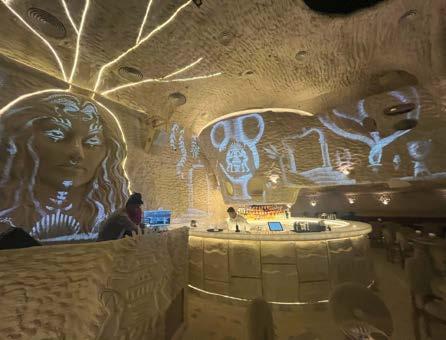
5 minute read
Projection Mapping: Restro & Bar
IMAGINATION MEETS INTENT: HOW DOT MAVERICKS CRAFTED AN IMMERSIVE ESCAPE AT ‘COVAH – THE CAVERN’, GURUGRAM
While experiential spaces are fast becoming the standard, Tier-I and II cities like Gurugram are pushing new adoptions even in restaurants, cafés, and hotels. DoT Mavericks, known for turning cityscapes and historic façades into immersive canvases, saw this opportunity as something more than a projection project. The team transformed COVAH – The Cavern, a restro-bar, into one of Gurugram’s most unique hospitality experiences. This feature shares an insightful story on how DoT Mavericks immerses COVAH’s diners through projection mapping on the walls of COVAH and its technical expertise that went behind crafting the unique ambience.
In a city where most restaurants jostle for attention with blaring speakers and neon theatrics, COVAH – The Cavern, a restro-bar in Gurugram, India, takes an entirely different route. Tucked into the heart of Sector 43, this restro-bar draws guests into its story. The cave-like walls, ceiling, and even lighting ensures the guests’ immersive experiences at COVAH.
This was the outcome of an ambitious, open-ended vision, and it took DoT Mavericks India LLP to bring it to life. When COVAH’s creators approached DoT Mavericks, they had a desire to build a space that didn’t just serve food and drinks but immersed people in an experience. In fact, DoT Mavericks has delivered a space that no one has attempted before. The team built the blueprint from scratch, transforming raw sketches and cave-inspired dreams into one of Gurugram’s most unique hospitality experiences.
The Challenge: Breathing Life into Stone
While most projects come with measurements and material plans, this one came with a provocation: “We want to build a cave. And we want the cave to move.”
The idea was as poetic as it was technically complex. For DoT Mavericks, the challenge was to create an immersive experience on a canvas no one had worked with before. The walls of COVAH weren’t smooth drywall or polished cement. They were hand-sculpted from a blend of cow dung, coconut husk, and lime materials that are breathable, natural, and deeply textured. Beautiful? Yes. But incredibly unpredictable when it comes to light behavior, color absorption, and projection mapping. Every surface reflected visuals differently, every curve distorted the image in subtle ways.
Turning these surfaces into projection canvases was a challenge most would walk away from. However, DoT Mavericks ensured the delivery of every inch like a moving sculpture.
Precision Projection Mapping: Aligning visuals flawlessly to the contours of the restaurant’s architecture was paramount. Every corner, curve, and surface had to be accounted for to ensure seamless storytelling.
Lighting Management: Maintaining the vibrancy and clarity of the projections, even amidst fluctuating ambient lighting, demanded innovative calibration and strategic adjustments.
Spatial Constraints: The centrepiece of COVAH - a circular ceiling LED screen presented a unique challenge. Achieving distortion-free visuals on a 360-degree canvas required meticulous 3D mapping.
Content Customisation: Each immersive theme needed to be intricately designed to evoke emotion and immerse guests in the narrative, all while complementing the dining experience.
While most projects come with measurements and material plans, this one came with a provocation: We want to build a cave. And we want the cave to move.
The Solution: Integrating The Perfect Visuals
The team leaned in as they conducted a full LIDAR scan of the entire interior, capturing every curve, recess, and angle. With this hyper-detailed digital model, the team was able to map visuals with pixel-level precision. No distortion. No guesswork.
Then came the centerpiece: a 2.5-metre circular screen, designed not to stand out, but to integrate. It looks like the core of the space rather than just an add-on. Projection-mapped content flows in and out of it, syncing with the vibe of the space.
Using BenQ’s LU960ST2 projector, the team delivered stunning brightness, fast response, and short-throw projection, all essential to navigate the room’s tight, intimate structure. The 5200 ANSI lumens projector for crystal-clear imagery, captivated the vivid details with its WUXGA (1920x1200) resolution, 16:10 aspect ratio, and 3,000,000:1 contrast ratio.
A Collaboration Built on Artistic Intent
Given the layered complexity of the project, DoT Mavericks worked closely with Pink Noise Professionals Pvt. Ltd., the official distributors of EAW in India. The brand deployed its state-of-the-art EAW audio system to enhance every projection with immersive soundscapes. Pink Noise even stepped beyond their typical role to directly support the installation and tuning, which is something they reserve only for standout projects.

Why It Matters
For DoT Mavericks, this was a statement. It proved that immersive storytelling belongs as much to lifestyle spaces as it does to museums or festivals. That diners, too, crave a multi-sensory journey. And that with the right blend of technology and design, hospitality venues can become destinations and spaces that inspire, engage, and linger in memory.
In cities like Gurugram, where the bar for experience is rising every day, the success of COVAH sets a precedent. It shows how new-age customers are hungry for such innovations.
Crafting the Future of Spaces
DoT Mavericks India LLP continues to lead the charge in experiential design, whether it’s a palace façade, a city monument, or an underground bar that wants to feel like another dimension. Their work at COVAH is a glowing example of what happens when imagination meets intent and when audio-visual design becomes a form of storytelling.
Ankur Srivastav, Director, Experiential Technologies, shared, “The artist sees it as a piece of art”. When I visited the place for the first time, I felt a tremendous amount of energy not only because it is fascinating but to see the architectural façade to make an experience. It is like reaching a dream destination. While designing this project, I had a vision to create an immersive installation which, will become a symbol in Gurugram, and we succeeded.”



